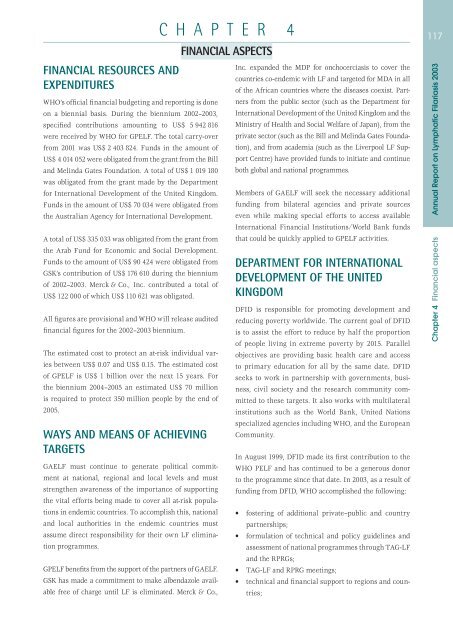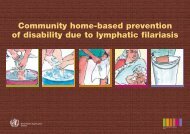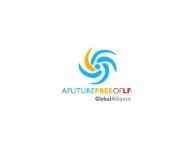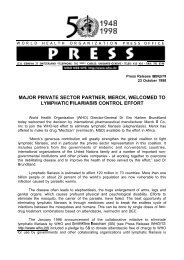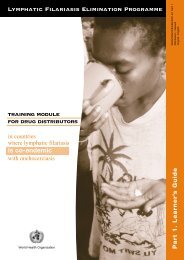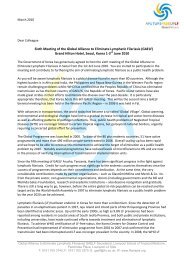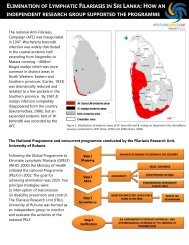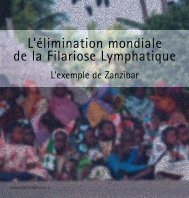Global Programme to Eliminate Lymphatic Filariasis ... - libdoc.who.int
Global Programme to Eliminate Lymphatic Filariasis ... - libdoc.who.int
Global Programme to Eliminate Lymphatic Filariasis ... - libdoc.who.int
Create successful ePaper yourself
Turn your PDF publications into a flip-book with our unique Google optimized e-Paper software.
C H A P T E R 4FINANCIAL ASPECTSFINANCIAL RESOURCES ANDEXPENDITURESWHO’s official financial budgeting and reporting is doneon a biennial basis. During the biennium 2002–2003,specified contributions amounting <strong>to</strong> US$ 5 942 816were received by WHO for GPELF. The <strong>to</strong>tal carry-overfrom 2001 was US$ 2 403 824. Funds in the amount ofUS$ 4 014 052 were obligated from the grant from the Billand Melinda Gates Foundation. A <strong>to</strong>tal of US$ 1 019 180was obligated from the grant made by the Departmentfor International Development of the United Kingdom.Funds in the amount of US$ 70 034 were obligated fromthe Australian Agency for International Development.A <strong>to</strong>tal of US$ 335 033 was obligated from the grant fromthe Arab Fund for Economic and Social Development.Funds <strong>to</strong> the amount of US$ 90 424 were obligated fromGSK’s contribution of US$ 176 610 during the bienniumof 2002–2003. Merck & Co., Inc. contributed a <strong>to</strong>tal ofUS$ 122 000 of which US$ 110 621 was obligated.All figures are provisional and WHO will release auditedfinancial figures for the 2002–2003 biennium.The estimated cost <strong>to</strong> protect an at-risk individual variesbetween US$ 0.07 and US$ 0.15. The estimated cos<strong>to</strong>f GPELF is US$ 1 billion over the next 15 years. Forthe biennium 2004–2005 an estimated US$ 70 millionis required <strong>to</strong> protect 350 million people by the end of2005.WAYS AND MEANS OF ACHIEVINGTARGETSGAELF must continue <strong>to</strong> generate political commitmentat national, regional and local levels and muststrengthen awareness of the importance of supportingthe vital efforts being made <strong>to</strong> cover all at-risk populationsin endemic countries. To accomplish this, nationaland local authorities in the endemic countries mustassume direct responsibility for their own LF eliminationprogrammes.GPELF benefits from the support of the partners of GAELF.GSK has made a commitment <strong>to</strong> make albendazole availablefree of charge until LF is eliminated. Merck & Co.,Inc. expanded the MDP for onchocerciasis <strong>to</strong> cover thecountries co-endemic with LF and targeted for MDA in allof the African countries where the diseases coexist. Partnersfrom the public sec<strong>to</strong>r (such as the Department forInternational Development of the United Kingdom and theMinistry of Health and Social Welfare of Japan), from theprivate sec<strong>to</strong>r (such as the Bill and Melinda Gates Foundation),and from academia (such as the Liverpool LF SupportCentre) have provided funds <strong>to</strong> initiate and continueboth global and national programmes.Members of GAELF will seek the necessary additionalfunding from bilateral agencies and private sourceseven while making special efforts <strong>to</strong> access availableInternational Financial Institutions/World Bank fundsthat could be quickly applied <strong>to</strong> GPELF activities.DEPARTMENT FOR INTERNATIONALDEVELOPMENT OF THE UNITEDKINGDOMDFID is responsible for promoting development andreducing poverty worldwide. The current goal of DFIDis <strong>to</strong> assist the effort <strong>to</strong> reduce by half the proportionof people living in extreme poverty by 2015. Parallelobjectives are providing basic health care and access<strong>to</strong> primary education for all by the same date. DFIDseeks <strong>to</strong> work in partnership with governments, business,civil society and the research community committed<strong>to</strong> these targets. It also works with multilateralinstitutions such as the World Bank, United Nationsspecialized agencies including WHO, and the EuropeanCommunity.In August 1999, DFID made its first contribution <strong>to</strong> theWHO PELF and has continued <strong>to</strong> be a generous donor<strong>to</strong> the programme since that date. In 2003, as a result offunding from DFID, WHO accomplished the following:• fostering of additional private–public and countrypartnerships;• formulation of technical and policy guidelines andassessment of national programmes through TAG-LFand the RPRGs;• TAG-LF and RPRG meetings;• technical and financial support <strong>to</strong> regions and countries;117Annual Report on <strong>Lymphatic</strong> <strong>Filariasis</strong> 2003Chapter 4 Financial aspects


